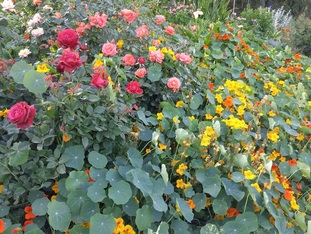| | Oh, the wonderful color and billowing foliage! The rains and the warmth have literally blossomed beautifully! A week means another foot taller and more fully-developed foliage, and blooms rising above the greenery. My oceans of nasturtiums are like waves of color with each breeze. Peaches are the size of quarters and need hurried thinning of crowded ones. Boysenberries are blossoming and set with dimesize green fruits. First “brebra” figs are set on last-year’s brown wood. I’ve even let tomato blossoms set on plants that are now two feet tall, knowing that they’re firmly established after transplanting a month ago and capable of both growing and producing fruits. If I’d let them set their blossoms earlier, I’d be concerned that I was forcing the plant to expend its energy developing the fruit instead of establishing itself well into its new home and developing an extensive root system. Planting Tomatoes New tomato plants that I’ll still purchase over the next couple of weeks, I’ll plant deeply (up to their very topknot of three leaves) to foster more roots, create a watering berm a foot away from the stem as basins to direct irrigation water downward, and water deeply for two weeks to get the roots to “learn” to grow deeply into the soil “chasing” the gravity-directed water. On those newly-planted tomatoes, I’ll pluck off all blossoms and any fruit for at least a month, until the plants are at least two feet tall. Then, I’ll let them set their blossoms and fruit because I know that they’ve developed excellent root systems and are absorbing all the great nutrition from the manure- and compost-enriched soil. Starting Summer Seeds The coming week, with its mid-60s air temperatures, is perfect for transplanting and for starting seeds. Now that soil temperatures are warmer, summer veggies to plant the seeds include beans, cucumbers, and squash. These all produce a lot of food for the amount of space they take in the garden, especially when they're grown up on trellises. There are many varieties of each to try to see which you prefer, so plant a few at a time every three weeks so you’ll have a continuous but not overwhelming supply – unless you want to preserve them, of course, which means you’ll prefer harvesting a lot all at once. Also be sure to plant edibles that take a long time to mature, like pumpkins and melons, which will also take a lot of water to develop fully, and space to “run”. But, with lots of manure and compost and mulch and specific watering techniques, all of these issues can be dealt with successfully. More on those watering techniques later, especially on using 5-gallon nursery containers with holes in their bottoms! |
|
0 Comments
 Different varieties of lettuce bolt at different times, some continuing to be edible while others become too bitter. Different varieties of lettuce bolt at different times, some continuing to be edible while others become too bitter. The lettuce has finally gotten too bitter for me to harvest for salads, so I’ve pulled out the plants and planted new seedlings. But, I’ve gotten a good month’s worth of lettuce harvests since that several-week long bout of heat that shifted the lettuce hormones from growing to bolting – elongating into “trees” on their way to setting seed – that turned the lettuce bitter. Here’s how I salvaged all that lettuce, in four steps. First, I tasted a single leaf from every plant to see whether I could still enjoy it. The potential for bitterness is individual to each variety and each plant, so you can’t generalize; you must taste each plant. Then, if the test-leaf is acceptable, you can go ahead and harvest that plant – but only the younger leaves, leaving the top 4 baby-sized leaves for further growth. Cleanly tear off the older leaves for the compost pile – you don’t want to leave any foliage bits to attract snails and slugs. The remaining plant will look like a stick with a topknot on it. Second, any plants that had become too bitter in my taste test, I pulled and added to the compost pile. Thirdly, I watered in the lettuce bed to encourage the plants to continue to grow quickly in the hopefully cooler soil and air temperatures for yet another week at least until the next batch of leaves had developed for harvest – or at least the next taste-test. Fourth, I took all of the harvested leaves into the kitchen and filled the sink with water, then gently turned the leaves into the water, gently submerging the leaves a couple of times and scooping off any of the bits of mulch. Let the lettuce soak for 15-30 minutes, submerging them a couple of times to make sure they’ve all been under the water for some of that time. Again gently, transfer a small handful of leaves from the water to a colander until they’re all out of the water. Drain the water, and remove any more mulch bits. Refill the sink. Put the leaves back into the water a second time, submerging and leaving for another 15 minutes or so. This double-soaking process accomplishes two things – exchanging some or most of the bitter elements for plain water, and crisping up the lettuce. Back into the colander to drain slightly, then into ziplock bags into the refrigerator, pressing out most of the air when you zip the lock, these bags will keep the lettuce fresh and crisp for up to a week. This technique will also work later in the season, when the weather really heats up for summer, and my just-planted lettuce will do its reproductive thing and bolt. Remember though, that if you truly loved some of that lettuce (that weren’t hybrid varieties), you can leave the bolting plant to develop fully so you can harvest the seed. It’ll take about another month to six weeks to complete this process because you must allow the plant to mature until it’s crispy-dry before harvesting the seed.
|
Categories |



























 RSS Feed
RSS Feed